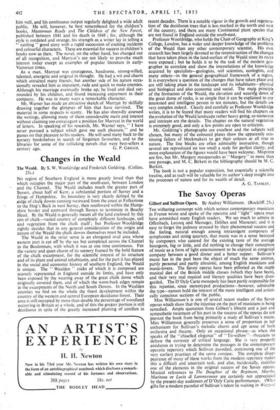Changes in the Weald
The Weald. By S. W. Wooldridge and Frederick Goldring. (Collins. 25s.) No region of Southern England is more greatly loved than that which occupies the major part of the south-east, between London and the Channel. The Weald includes much the greater part of Sussex, about half of Kent, a substantial portion of Surrey and a fringe of Hampshire. Its boundary is very clearly defined by the oidge of chalk downs running westward from the coast at Folkestone to the Hog's.Back in west Surrey, then southward within the Hamp- shire border and eastward through Sussex to terminate in Beachy Head. By the Weald is generally meant all the land enclosed by this rim of chalk—varied country of completely different landscape, soil and vegetation from the chalk itself; but Professor Wooldridge rightly decides that in any general consideration of the origin and nature of the Weald the chalk downs themselves must be included.
The Weald in the strict sense is an elongated oval area whose eastern part is cut off by the sea but completed across the Channel in the Boulonnais, with which it was at one time continuous. For the variety and quiet charm of its scenery framed by the bold feature of the chalk escarpment, for the scientific interest of its structure and of its plant and animal inhabitants, and for the part it has played in the social and economic history of southern England, the Weald is unique. The " Wealden " rocks of which it is composed are scarcely represented in England outside its limits, and have only been exposed by the wearing away of the great chalk dome which originally covered them, and of which the worn-back edges remain in the escarpments of the North and South Downs. In the Wealden counties we find on the whole the finest development within the country of the western and central European deciduous forest. Their area is still occupied by more than double the percentage of woodland occurring in Britain as a whole, and of this the grekter portion is still deciduous in spite of the greatly increased planting of conifers in recent decades. There is a notable vigour in the growth and regenera- tion of the deciduous trees that is less marked in the north and west of the country, and there are many Continental plant species that are not found in England outside the south-east.
Professor Wooldridge, who holds the Chair of Geography at King's College, London, has a wider and deeper knowledge of the problems of the Weald than any other contemporary scientist. His own research has been largely devoted to the reconstruction of the changes that have taken place in the land-surface of the Weald since its rocks were exposed ; but he holds it to be the task of the modern geo- grapher to correlate and show the interrelations of the knowledge acquired by specialists—geologists, soil scientists, ecologists, and many others—in the general geographical framework of a region. It is everywhere a question of the changes that have taken place and are still taking place in the landscape and its inhabitants—physical and biological and also economic and social. The ma.if principle of the formation of the Weald, the elevation and wearing down of the great dome of rocks, is so simple that it can be explained to any interested and intelligent person in ten minutes, but the details are very complex indeed. Clearly and carefully as Professor Wooldridge writes, it is to be feared that many readers will find his chapters on the evolution of the Weald landscape rather heavy going, so numerous and intricate are the details. The chapter on the natural vegetation is extremely good, and only a few points are open to criticism.
Mr. Goldring's photographs are excellent and the subjects well chosen, but many of the coloured plates show the apparently con- tinuing failure of blockmakers to get their colours at all true to nature. The line blocks are often admirably instructive, though several are reproduced on too small a scale for perfect clarity, and more explanation of the figures would have been welcome. Misprints are few, but Mr. Margary masquerades as " Margery" in more than one passage, and M. C. Birkett in the bibliography should be M. C. Burkitt.
The book is not a popular exposition, but essentially a scientific treatise, and as such will be valuable for its author's deep insight into the processes of nature and for its wealth of detail.
A. G. TANSLEY.


































 Previous page
Previous page